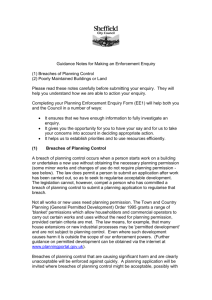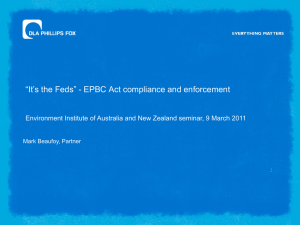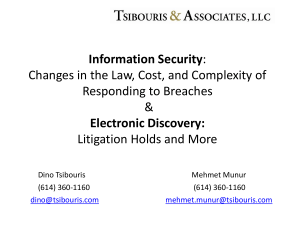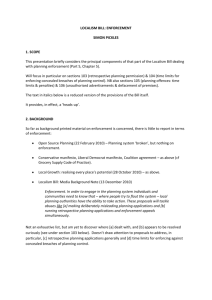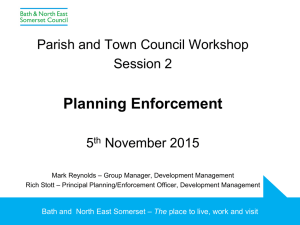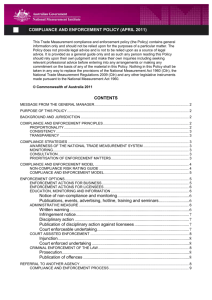ANNEX 1: GLOSSARY OF ENFORCEMENT TOOLS AND REMEDIES
advertisement
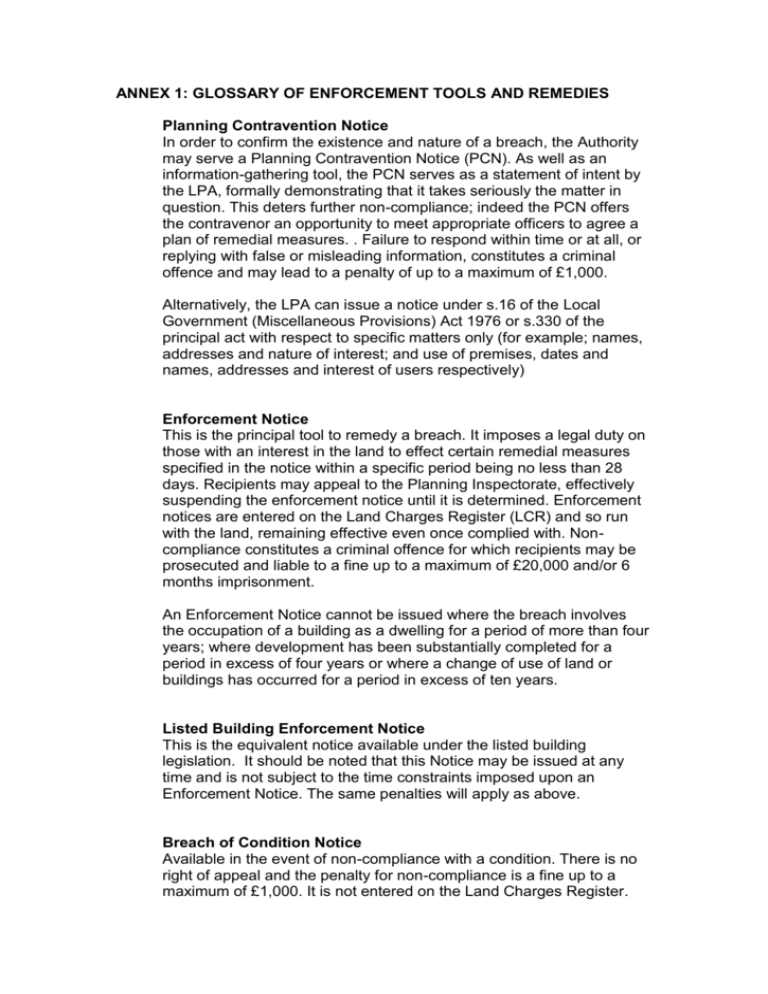
ANNEX 1: GLOSSARY OF ENFORCEMENT TOOLS AND REMEDIES Planning Contravention Notice In order to confirm the existence and nature of a breach, the Authority may serve a Planning Contravention Notice (PCN). As well as an information-gathering tool, the PCN serves as a statement of intent by the LPA, formally demonstrating that it takes seriously the matter in question. This deters further non-compliance; indeed the PCN offers the contravenor an opportunity to meet appropriate officers to agree a plan of remedial measures. . Failure to respond within time or at all, or replying with false or misleading information, constitutes a criminal offence and may lead to a penalty of up to a maximum of £1,000. Alternatively, the LPA can issue a notice under s.16 of the Local Government (Miscellaneous Provisions) Act 1976 or s.330 of the principal act with respect to specific matters only (for example; names, addresses and nature of interest; and use of premises, dates and names, addresses and interest of users respectively) Enforcement Notice This is the principal tool to remedy a breach. It imposes a legal duty on those with an interest in the land to effect certain remedial measures specified in the notice within a specific period being no less than 28 days. Recipients may appeal to the Planning Inspectorate, effectively suspending the enforcement notice until it is determined. Enforcement notices are entered on the Land Charges Register (LCR) and so run with the land, remaining effective even once complied with. Noncompliance constitutes a criminal offence for which recipients may be prosecuted and liable to a fine up to a maximum of £20,000 and/or 6 months imprisonment. An Enforcement Notice cannot be issued where the breach involves the occupation of a building as a dwelling for a period of more than four years; where development has been substantially completed for a period in excess of four years or where a change of use of land or buildings has occurred for a period in excess of ten years. Listed Building Enforcement Notice This is the equivalent notice available under the listed building legislation. It should be noted that this Notice may be issued at any time and is not subject to the time constraints imposed upon an Enforcement Notice. The same penalties will apply as above. Breach of Condition Notice Available in the event of non-compliance with a condition. There is no right of appeal and the penalty for non-compliance is a fine up to a maximum of £1,000. It is not entered on the Land Charges Register. Stop Notice In the most serious cases the Council may decide to issue a Stop Notice. This Requires cessation, normally within a minimum of 3 days, of unauthorised activities where they cause severe harm to local amenity. If a statement of special reasons is attached, the notice may come into effect within 3 days. The duty to comply is universal and not limited to recipients of the notice. However, its disadvantage is that it can only be served with or after an enforcement notice but before the effective date. Also, it cannot prohibit the use of a building as a dwelling nor any operational development, if carried out for more than 4 years before service. The improper use of a Stop Notice incurs the Local Planning Authority risking liability to and compensating owners or occupiers for losses directly attributable to the service of the notice. Temporary Stop Notice This recently-introduced measure has a number of advantages. Firstly, it is effective immediately and does not require the prior service of an enforcement notice. Moreover, the risks of liability for compensation are negligible if the notice is issued correctly. However, it can subsist only for a maximum of 28 days and cannot be renewed. Further advice on Temporary Stop Notices can be found in Government Circular 02/2005 (Temporary Stop Notice) Court Injunction This may be sought in the most serious cases to restrain anticipated breaches as well as to prevent actual breaches. Non-compliance, is considered to be a contempt of court and may result in a fine and/or imprisonment. However, this remedy is costly to the Council and depends upon the discretion of the judge. Untidy Land (s.215) Notice This encompasses buildings as well as land. The LPA need only show that amenity is adversely affected by the state of the premises. Appeals are to the Magistrates’ Court and not to the Secretary of State. Noncompliance constitutes a criminal offence for which recipients may be prosecuted and are liable to a fine up to a maximum of £1,000. Advertisements All sites for the placement of advertisements, other than those that are exempt under the terms of the Town and Country Planning (Control of Advertisements) Regulations 1992, require consent, be that deemed or express. Any person who displays an advertisement on a site in contravention of the Regulations is guilty of an offence under section 224 (3) of the Town and Country Planning Act 1990 and is liable to a fine on conviction. A Discontinuance Notice can be served in respect of adverts that have deemed consent and this is the relevant and more stringent power to remedy a ‘substantial injury’ to an amenity or where danger is caused to members of the public. The notice cannot take effect less than 8 weeks after service date and can be appealed. Prosecution Prosecution is one of the remedies available in respect of a breach of any of the notices listed above (excluding Court Injunctions) and this action will be taken where there is sufficient evidence and it is in the public interest in accordance with the Code of Crown Prosecutors. Defendants may thus be deterred from continued non-compliance, as well as punished for proven breaches. Direct Action (with costs recovery) This is potentially the quickest remedy and involves the Council itself taking steps to remedy the breach, for example by removing an unauthorised building. The Council then recovers the costs of this from the offender. Unlike prosecution, exercising such default powers secures actual resolution. These powers only arise in the event of noncompliance with enforcement and untidy land notices. Further legal action may also need to be taken to recover the costs which can be a lengthy and expensive process. However it should be noted that the costs can be registered as a local land charge and therefore should be recovered if the land is sold. In addition it may be possible for the Council to force sale of the land in order to recover these costs. It should be noted that there is no specific budget available within the Council finances for this course of action to be taken and the initial cost to the Council to remedy the breach could be significant.



